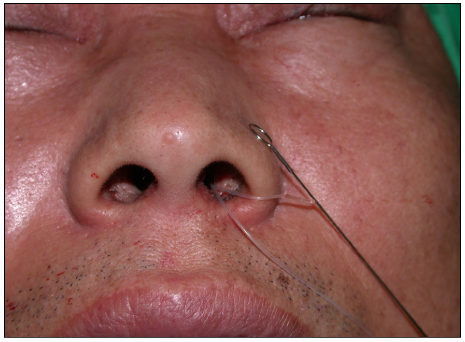J Korean Ophthalmol Soc.
2012 Nov;53(11):1554-1558.
Long Term Effect of Double Silicone Tube Intubation for Acquired Nasolacrimal Duct Obstruction
- Affiliations
-
- 1Department of Ophthalmology, Chonbuk National University Hospital, Chonbuk National University Medical School, Jeonju, Korea. ahnmin@jbnu.ac.kr
Abstract
- PURPOSE
To evaluate the long term effectiveness of double silicone tube intubation in the treatment of acquired nasolacrimal duct (NLD) obstruction.
METHODS
The authors treated 68 eyes of 40 patients with acquired NLD obstruction. The resolution of preoperative symptoms and signs of NLD obstruction was evaluated 18 months after the operation.
RESULTS
The mean age of patients was 64.7 years and the mean follow-up period was 24.91 months. The symptoms and signs of NLD obstruction were improved in 85.29% of the patients. The partially obstructed group showed a higher success rate (89.29%) than the completely obstructed group (50.0%). A prolapse of silicone tubes to the ocular side was observed in 2 eyes, and 2 eyes had inflammatory signs after the procedure.
CONCLUSIONS
Double silicone tube intubation is an effective primary therapy with NLD obstruction, especially for patiensts with simple partially obstructed NLD instead of dacryocystorhinostomy.
MeSH Terms
Figure
Reference
-
1. Oum JS, Park JW, Choi YK, et al. Result of partial nasolacrimal duct obstruction after silicone tube intubation. J Korean Ophthalmol Soc. 2004. 45:1777–1782.2. Gibbs DC. New probe for the intubation of lacrimal canaliculi with silicone rubber tubing. Br J Ophthalmol. 1967. 51:198.3. Dortzbach RK, France TD, Kushner BJ, Gonnering RS. Silicone intubation for obstruction of the nasolacrimal duct in children. Am J Ophthalmol. 1982. 94:585–590.4. Sohn HY, Hur J, Chung EH, Won IG. Clinical observation on silicone intubation in obstruction of lacrimal drainage system. J Korean Ophthalmol Soc. 1990. 31:135–140.5. Yoon TJ, Na KS, Yoon WJ. The effect of silicone tube intubation in pediatric nasolacrimal duct obstruction. J Korean Ophthalmol Soc. 2002. 43:155–159.6. Ham DI, Yu YS. Silicone intubation in children with nasolacrimal duct obstruction. J Korean Ophthalmol Soc. 1991. 32:409–414.7. Cho KW, Lee SY, Kim SJ. Treatment of congenital nasolacrimal duct obstruction using silicone intubation set. J Korean Ophthalmol Soc. 1995. 36:553–558.8. Mun HJ, Chung WS. Surgical efficacy of probing with silicone intubation for lacrimal apparatus obstruction in children. J Korean Ophthalmol Soc. 2002. 43:2375–2381.9. Kwon YH, Lee YJ. Long-term results of silicone tube intubation in incomplete nasolacrimal duct obstruction (NLDO). J Korean Ophthalmol Soc. 2008. 49:190–194.10. Kim YK, Oh SU, Lee HC. Silicone intubation for canalicular or common canalicular obstruction in adult. J Korean Ophthalmol Soc. 2001. 42:1655–1660.11. Lee SH, Kim SD, Kim JD. Silicone intubation for nasolacrimal duct obstruction in adult. J Korean Ophthalmol Soc. 1997. 38:185–189.12. Lee CO, Kim JH, Jong SH. Success rate of silicone tube intubation. J Korean Ophthalmol Soc. 1997. 38:1921–1925.13. Lee HS, Hwang WS, Byun YJ. Clinical results of silicone intubation for nasolacrimal duct obstruction in adult. J Korean Ophthalmol Soc. 1997. 38:1926–1930.14. Kim HD, Jeong SK. Silicone tube intubation in acquired nasolacrimal duct obstruction. J Korean Ophthalmol Soc. 2000. 41:327–331.15. Park JJ, Shin DS, Hong SP, Lee KW. Effects of double silicone tube intubation for nasolacrimal duct obstruction in adults. J Korean Ophthalmol Soc. 2005. 46:1951–1956.16. Park JS, Ha SW, Lew H. Factors affecting the long-term outcome of silicone tube intubation in patients with nasolacrimal duct obstruction. J Korean Ophthalmol Soc. 2011. 52:129–135.17. Kim IT, Lee KJ, Seo HD. The extent of patient's content for epiphora and skin scar in external dacryocystorhinostomy operation. J Korean Ophthalmol Soc. 1997. 38:343–350.18. Tucker SM, Linberg JV, Nguyen LL, et al. Measurement of the resistance to fluid flow within the lacrimal outflow system. Ophthalmology. 1995. 102:1639–1645.19. Mauffray RO, Hassan AS, Elner VM. Double silicone intubation as treatment for persistent congenital nasolacrimal duct obstruction. Ophthal Plast Reconstr Surg. 2004. 20:44–49.20. Anderson RL, Edwards JJ. Indications, complications and results with silicone stents. Ophthalmology. 1979. 86:1474–1487.
- Full Text Links
- Actions
-
Cited
- CITED
-
- Close
- Share
- Similar articles
-
- Treatment of Congenital Nasolacrimal Duct Obstruction Using Silicone Intubation Set
- Management of Prolapsed Silicone Tube Inserted for Treatment of Nasolacrimal Duct Obstruction
- Long-term Results of Silicone Tube Intubation in Incomplete Nasolacrimal Duct Obstruction (NLDO)
- Silicone Tube Intubation in Acquired Nasolacrimal Duct Obstruction
- Silicone Intubation for Nasolacrimal Duct Obstruction in Adult




